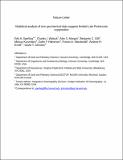| dc.contributor.author | Sperling, Erik | |
| dc.contributor.author | Wolock, Charles J. | |
| dc.contributor.author | Morgan, Alex S. | |
| dc.contributor.author | Gill, Benjamin C. | |
| dc.contributor.author | Kunzmann, Marcus | |
| dc.contributor.author | Halverson, Galen P. | |
| dc.contributor.author | Macdonald, Francis Alexander | |
| dc.contributor.author | Knoll, Andrew Herbert | |
| dc.contributor.author | Johnston, David T | |
| dc.date.accessioned | 2016-07-21T15:41:47Z | |
| dc.date.issued | 2015 | |
| dc.identifier.citation | Sperling, Erik A., Charles J. Wolock, Alex S. Morgan, Benjamin C. Gill, Marcus Kunzmann, Galen P. Halverson, Francis A. Macdonald, Andrew H. Knoll, and David T. Johnston. 2015. “Statistical Analysis of Iron Geochemical Data Suggests Limited Late Proterozoic Oxygenation.” Nature 523 (7561) (July 22): 451–454. doi:10.1038/nature14589. | en_US |
| dc.identifier.issn | 0028-0836 | en_US |
| dc.identifier.uri | http://nrs.harvard.edu/urn-3:HUL.InstRepos:27716502 | |
| dc.description.abstract | Sedimentary rocks deposited across the Proterozoic–Phanerozoic transition record extreme climate fluctuations, a potential rise in atmospheric oxygen or re-organization of the seafloor redox landscape, and the initial diversification of animals. It is widely assumed that the inferred redox change facilitated the observed trends in biodiversity. Establishing this palaeoenvironmental context, however, requires that changes in marine redox structure be tracked by means of geochemical proxies and translated into estimates of atmospheric oxygen. Iron-based proxies are among the most effective tools for tracking the redox chemistry of ancient oceans. These proxies are inherently local, but have global implications when analysed collectively and statistically. Here we analyse about 4,700 iron-speciation measurements from shales 2,300 to 360 million years old. Our statistical analyses suggest that subsurface water masses in mid-Proterozoic oceans were predominantly anoxic and ferruginous (depleted in dissolved oxygen and iron-bearing), but with a tendency towards euxinia (sulfide-bearing) that is not observed in the Neoproterozoic era. Analyses further indicate that early animals did not experience appreciable benthic sulfide stress. Finally, unlike proxies based on redox-sensitive trace-metal abundances, iron geochemical data do not show a statistically significant change in oxygen content through the Ediacaran and Cambrian periods, sharply constraining the magnitude of the end-Proterozoic oxygen increase. Indeed, this re-analysis of trace-metal data is consistent with oxygenation continuing well into the Palaeozoic era. Therefore, if changing redox conditions facilitated animal diversification, it did so through a limited rise in oxygen past critical functional and ecological thresholds, as is seen in modern oxygen minimum zone benthic animal communities. | en_US |
| dc.description.sponsorship | Earth and Planetary Sciences | en_US |
| dc.language.iso | en_US | en_US |
| dc.publisher | Nature Publishing Group | en_US |
| dc.relation.isversionof | doi:10.1038/nature14589 | en_US |
| dash.license | LAA | |
| dc.title | Statistical analysis of iron geochemical data suggests limited late Proterozoic oxygenation | en_US |
| dc.type | Journal Article | en_US |
| dc.description.version | Accepted Manuscript | en_US |
| dc.relation.journal | Nature | en_US |
| dash.depositing.author | Macdonald, Francis Alexander | |
| dash.waiver | 2015-05-18 | |
| dc.date.available | 2016-07-21T15:41:47Z | |
| dc.identifier.doi | 10.1038/nature14589 | * |
| dash.contributor.affiliated | Sperling, Erik A. | |
| dash.contributor.affiliated | Macdonald, Francis | |
| dash.contributor.affiliated | Knoll, Andrew | |
| dash.contributor.affiliated | Johnston, David | |


